Contacts:
Lane Smith, NYSG’s Research Program Coordinator, E: Lane.Smith@stonybrook.edu, P: (631) 632-9780
Paul C. Focazio, Communications Manager, NYSG, E: paul.focazio@stonybrook.edu, P: (631) 632-6910
STONY BROOK, NY, June 18, 2024 — New York Sea Grant (NYSG) has awarded approximately $2.15 million to support 10 research projects, the results of which will directly address multiple high priority community, economic, and environmental objectives.
The projects — which will begin this fall and are administered by NYSG and funded through the National Oceanographic and Atmospheric Administration (NOAA), Sea Grant’s federal parent agency — represent a range of stakeholder-driven topics, across a number of New York’s coastal geographies, including the Hudson, Great Lakes, and marine districts.
Here are summaries of the 10 investigations ...
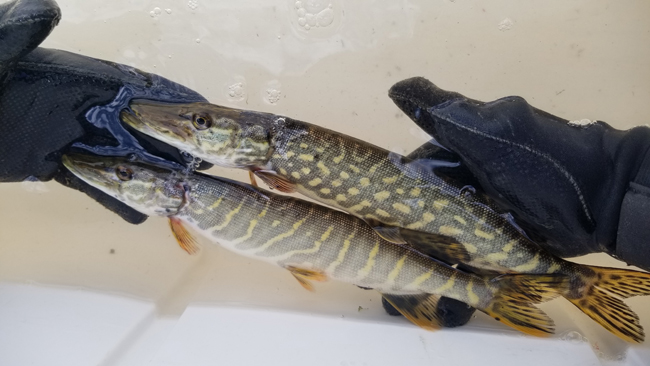
SUNY ESF investigators are examining how Northern pike, like these from the St. Lawrence River, are impacted by the dominance of invasive plants under similar water level regulation and climatic conditions. Credit: TIBS Archives
Characterizing Vegetative Zones as Functional Refugia to Improve Ecosystem Resilience and Fish Reproduction in Coastal Wetlands (R/CE-36, Dr. Emily R. Arsenault, and Dr. John M. Farrell, SUNY College of Environmental Science and Forestry)
Coastal wetlands provide animals with forage and refuge habitat. Rapidly spreading non-native (invasive) aquatic plants (NAP), climate change, and dam regulation can threaten these wetlands. Northern pike are ecologically, culturally, and economically important native predators in the St. Lawrence River that have changed their spawning distribution from historic wet meadow spawning areas to less optimal deeper nearshore areas in response to the proliferation of the invasive hybrid cattail (Typha x glauca) and water level regulation.
A research team at the SUNY College of Environmental Science and Forestry led by Dr. Emily Arsenault and Dr. John Farrell aims to compare Northern Pike populations between the St. Lawrence River, which is heavily influenced by the invasion of aquatic invasive plants and Cranberry Lake, which is not impacted by NAP. Cranberry Lake is hydrologically linked to the St. Lawrence River via the Oswegatchie River, thus both are similarly influenced by water level regulation.
The investigators will examine how Northern pike habitat provided by coastal wetlands is impacted by invasive plant dominance under similar water level regulation and climatic conditions. It is anticipated that the results will help inform water level and wetland management to support habitat for fish and invertebrates in the St. Lawrence River coastal region of New York State.
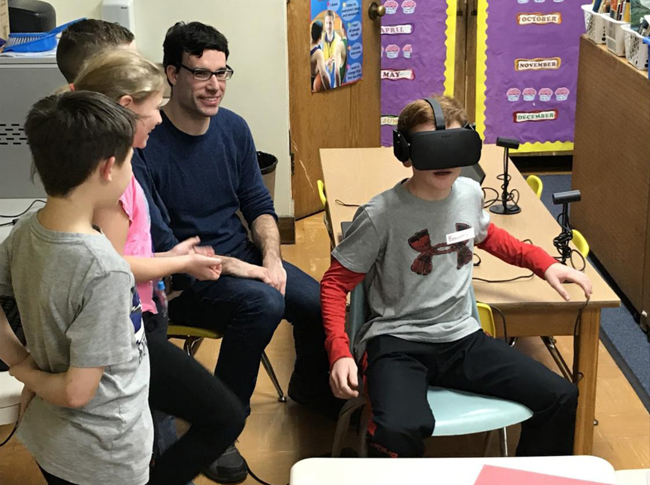
To help create a NYS K-12 curriculum standard specific to marine, coastal, or environmental science, a research team led by investigators at Hofstra University and Adelphi University will work on educational resources to train and inspire the next generation of scientists and environmental stewards. The key will be to emphasize innovative methods, including visual tools such as this virtual reality hurricane simulation that lead PI Jase Bernhardt (at left, in dark blue shirt) has brought to a classroom for students of a K-12 school on Long Island to experience. Credit: Jase Bernhardt
Developing and Evaluating an Interdisciplinary Coastal Science Curriculum (R/CHD-19, Dr. Jase E. Bernhardt, Hofstra University, and Dr. Mary Jean McCarthy, Adelphi University)
There is no standard K-12 curriculum in New York State that is both specific to marine, coastal, or environmental science, and relevant to communities that live in coastal zones. Barriers exist to the development, adoption, and evaluation of such a curriculum, including the limited time and the topical expertise of educators. Identifying key knowledge gaps in student understanding is another critical component of effective curriculum development.
To respond to these challenges, a research team led by Dr. Jase E. Bernhardt, of Hofstra University, and Dr. Mary Jean McCarthy, of Adelphi University will coordinate a team of experienced earth science educators at the secondary and postsecondary levels and will collaborate with local civic organizations to develop a community-focused coastal science curriculum inclusive of diverse viewpoints and includes coastal zones and communities in Long Island, New York City, and the Hudson River Estuary.
Completion of this project will result in educational resources to train and inspire the next generation of scientists and environmental stewards. The new curriculum will be evaluated with mixed methods research tools — different ways of gathering information, e.g., questionnaires, interviews, and/or classroom observations, that can supplement each other and hence boost the validity and dependability of the data — to provide insights into student knowledge gaps, the effectiveness of active learning approaches such as project- and place-based learning, and the overall experience of participating teachers.
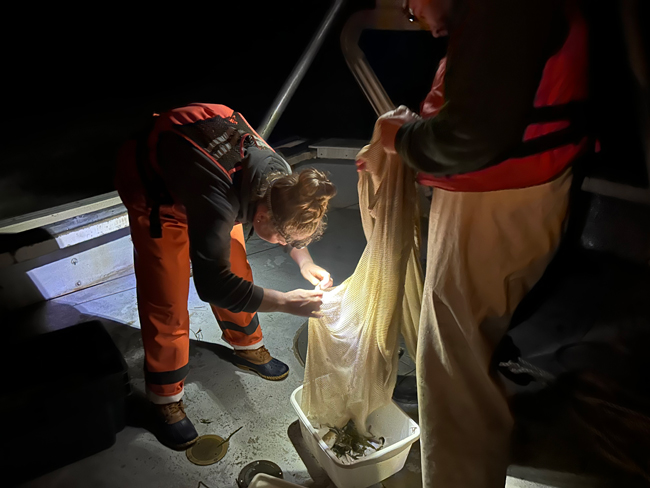
An aim of an NYS Department of Environmental Conservation-supported Fall Juvenile Survey, which is a source of data for an SBU-led NYSG-funded research project, is to collect data on juvenile fish in the Hudson River. (At right) Jared Parsons (Normandeau Associates, Inc.) holds the nets of a beam trawl while Katrina Rokosz (SBU) searches the net for juvenile fish. Credit: Willa Schultz
Developing an End-To-End Ecosystem Model to Inform Management of the Hudson River and New York Bight Ecosystem (R/FBF-27, Dr. Yong Chen, Stony Brook University)
The Hudson River Estuary (HRE) and the New York Bight (NYB) provide critical habitats for ecologically and economically important fish species. As fisheries management increasingly strives for an Ecosystem-Based Fisheries Management (EBFM) approach and contends with increasingly dynamic ecosystems influenced by multiple environmental and anthropogenic stressors, it is essential and necessary to consider HRE and NYB as connected ecosystems considering both ecological and environmental interactions within these two areas. Knowing how ecosystems respond to multiple stressors can be critical for achieving management objectives while avoiding undesirable outcomes.
To better understand the dynamics of the HRE-NYB ecosystem in the context of ongoing climate change and anthropogenic stressors, a new research project led by Dr. Yong Chen at Stony Brook University will develop and test a new ecosystem model that couples physical and biological processes to simulate the HRE-NYB ecosystem dynamics. This approach will help identify the key drivers and stressors that regulate the HRE-NYB ecosystem processes. The model can be used for evaluating different management scenarios in support of EBFM and spatial planning in the studied area.
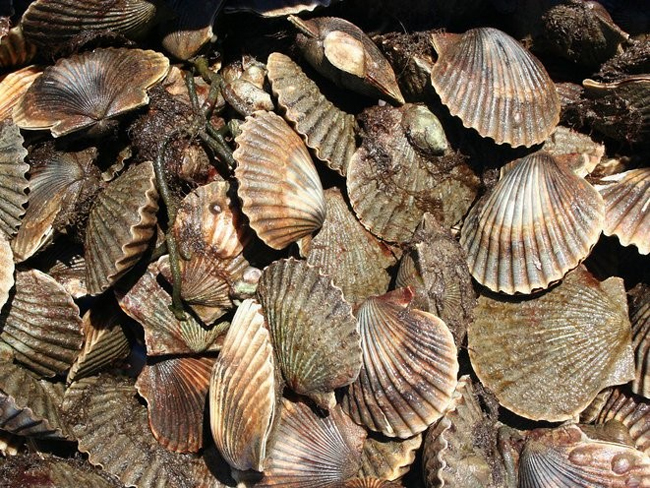
High temperatures and heat wave events have exacerbated the vulnerability of the bay scallop, seen here, to hypoxia (low dissolved oxygen) and contributed to the collapse of the fishery. Researchers at Stony Brook University are conducting studies to help ensure the future viability of this and other shellfisheries in NY. Credit: Stony Brook University
The Current and Future Impacts of Warming and Low Oxygen on The Sustainability of Shellfisheries Across New York (R/FBM-44, Dr. Michael H. Doall, Dr. Christopher J. Gobler, Stony Brook University; Dr. Stephen J. Tomasetti, University of Maryland Eastern Shore)
Historically some of the nation’s most productive fisheries, New York (NY) coastal shellfisheries are ecologically, economically, and culturally important. Over the last quarter century, two major NY shellfisheries, American lobster and hard clam, have collapsed due fully or in part to climate change-induced warming and persistent or daily recurring low oxygen (hypoxia). Most recently, the bay scallop fishery has experienced collapse and new research demonstrated that high temperatures and heat wave events have exacerbated the vulnerability of the bay scallop to hypoxia and contributed to the collapse of the fishery. Conversely, warming temperatures may benefit some existing or emerging shellfisheries such as Jonah crab and whelk.
Despite the risk or benefit of warming and the risk of hypoxia to regional shellfisheries, a comprehensive characterization of the temperature and dissolved oxygen (DO) dynamics in NY estuaries is lacking, and the impacts of future warming on the availability of habitat with suitable temperature and DO conditions for economically important species is unknown, prohibiting proactive management strategies and risking the possibility of further fishery collapses.
To help ensure the future viability of shellfisheries in NY, a research team at Stony Brook University led by Dr. Michael Doall will conduct analyses to characterize the dynamics of past, present, and future temperature and DO in NY estuaries and identify ideal and inhibitory locations across NY for each species, allowing managers, fishers, and aquaculturists to prepare for future change.
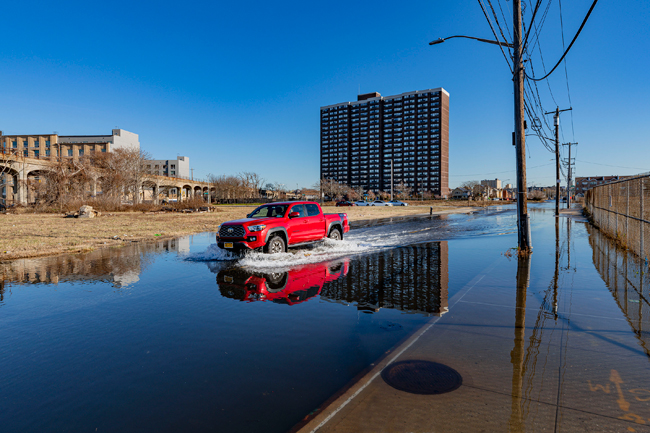
A research team from SBU will examine communicating flood risks from extreme rainfall and storm surges to vulnerable communities around Jamaica Bay. Here, a truck drives down a street near the shore in Far Rockaway, Queens impacted by a January 2022 “sunny day” high tide flood event, which, for comparison sake, is considered a chronic nuisance occurrence. Credit: Giles Ashford, NYC Community Flood Watch Project
Improving Risk Communication for Extreme Rainfall Events in Vulnerable Coastal Communities: A Case Study for Jamaica Bay (R/CHD-20, Dr. Donovan P. Finn, Dr. Christine Gilbert, and Dr. Kevin A. Finn, Stony Brook University)
Climate change has caused a significant increase in the frequency of extreme weather events in recent years. Extreme weather events, such as Hurricane Sandy, have heavily impacted the Jamaica Bay region of New York. Communicating flood risks to vulnerable communities from extreme rainfall and storm surges is challenging. As these events are predicted to increase in frequency and magnitude, it is increasingly important to effectively communicate to communities the risks associated with extreme weather events to ensure that they are well-prepared.
A research team at Stony Brook University led by Dr. Donovan Finn will combine expertise in climate science, community engagement, urban adaptation planning, and communication studies to address these risks. Advanced climate modeling and social science research will be coupled to produce and evaluate new strategies, building on the concept of climate "storylines." Storylines can be used to create narratives to effectively communicate facts and inform attitudes about climate change among the public. The investigators aim to test the effectiveness of storyline tools in increasing community members' understanding of the risks of extreme weather events.
Ultimately, this project will lead to new knowledge and tools for more effective communication of both short-term weather event risks and long-term challenges from climate change.
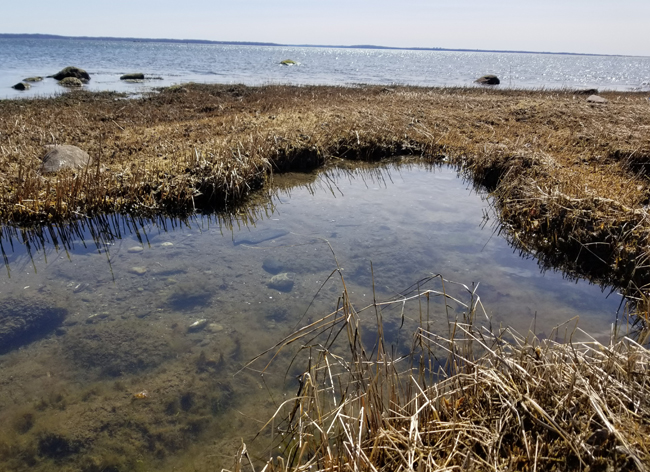
Investigators at SBU will examine hypoxic (low dissolved oxygen) conditions in locations along Long Island Sound’s western basin, where they most commonly occur. The early spring tide pools pictured here along the coast of Long Island Sound's western basin are located at the Edith Read Wildlife Sanctuary in Rye, NY. Credit: Lillit Genovesi/NYSG
AI-Based Forecast Tool for Prediction of Hypoxia Occurrence in Long Island Sound (R/CMB-52, Dr. Kamazima M. Lwiza, Stony Brook University)
Low dissolved oxygen (DO) or hypoxia continues to be a management challenge in Long Island Sound (LIS), especially in its western basin. Many factors play a role in the extent and intensity of low DO episodes in the LIS, making it a challenge to manage water quality to limit hypoxia. Identifying the factors affecting hypoxic volume and areal extent is crucial. This knowledge can be used to forecast and manage hypoxia by determining, for example, optimal allowable nutrient loads, which is the primary management tool for addressing LIS hypoxia.
Researchers led by Dr. Kamazima Lwiza at Stony Brook University aim to develop an enhanced predictive tool, compared to the standard three-dimensional hydrodynamic models, for hypoxic conditions and DO variability in Long Island Sound. The investigators propose developing a data-driven prediction tool based on a machine learning algorithm. Data-driven models require much less computational power than three-dimensional hydrodynamic models and can handle non-linear associations. Approaches using machine learning in analyzing hypoxia in coastal waters have been shown to produce highly accurate results in other locations, for example, Chesapeake Bay.
The machine learning approach to be developed will provide an efficient way of predicting water quality in LIS and help management and policymaking on nutrient load limits by reducing the uncertainty of hypoxia projections. Regional working groups and stakeholders have shown keen interest in developing an enhanced predictive tool for summer hypoxic conditions.
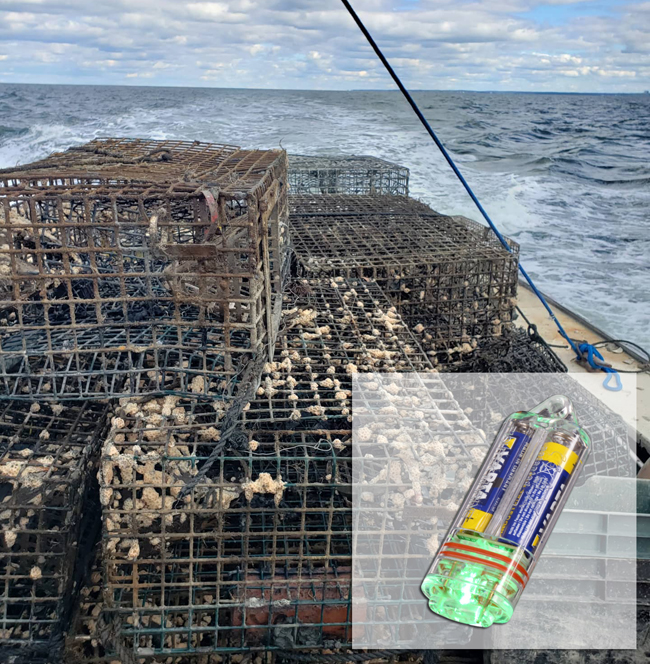
A Cornell Cooperative Extension of Suffolk County (CCE Suffolk) project will examine the effect of LEDs (Light Emitting Diodes) in pots of New York crustacean fisheries. In the past, Jonah crabs were an unintentional catch in the lobster harvester’s trap. More recently, the crabs are viewed as a target species. Commercial fish harvesters have increasingly been shifting their target species from lobster to Jonah crab due to changing species populations. Credit: CCE Suffolk; Inset: PotLights, a product for the crab and lobster fishing industry, are LED lights designed to increase catch rates while reducing or eliminating the need for natural baits. Credit: PotLights
Examining the Effect of LEDs (Light Emitting Diodes) in Pots of New York Crustacean Fisheries (R/FTD-13, Dr. Alexander J. Mercado, Dr. Michael S. Bowen, Cornell Cooperative Extension)
The decline in the lobster fishery in New York (NY) waters has resulted in a shift to Jonah crab (Cancer borealis) as an alternative fishery. Adapting to a new fishery resource can be a challenge for recreational and commercial fishers who have many years of experience targeting certain species in their traditional fishing areas. A research team led by Dr. Alexander J. Mercado and Dr. Michael S. Bowen, Cornell Cooperative Extension Marine Program (CCE), in collaboration with NY commercial fishers will examine the effect of deploying LED (light-emitting diode) lights on fishing pots in NY targeting Jonah crab in NY. The transition to this fishery may be aided by using a product called PotLights, which is effective in other crab pot fisheries. PotLights are LEDs designed to increase catch rates while reducing or eliminating the need for natural baits. This product has not been evaluated for use with Jonah crabs. Different combinations of light and bait (or absence of light and bait) will be compared to assess impacts on overall catch rates. If successful, the tool could reduce bait expenses for fishers and reduce harvest pressure on bait species such as herring, menhaden, and skate.
Successful results will economically benefit the fishing industry by reducing costs and have a positive environmental impact on bait species. CCE will include an outreach and education component to disseminate the results to relevant stakeholders.
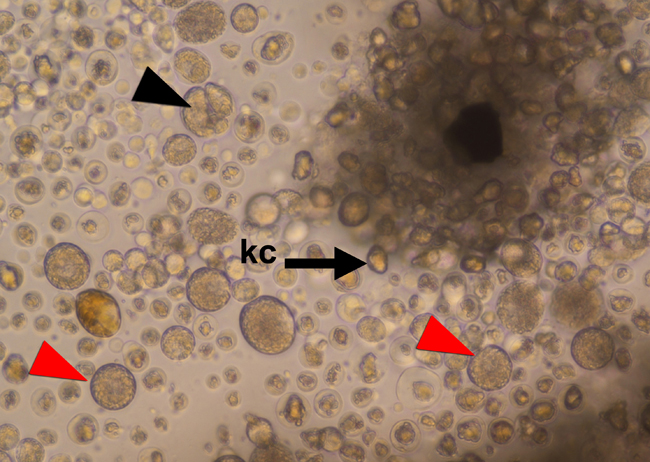
Stony Brook University investigators are helping to identify risk factors associated with shellfish disease outbreaks such as the bay scallop Marosporida (BSM), an emergent parasite of adult bay scallop seen here in a mixture of crushed scallop kidneys. Red and black arrowheads represent single and dividing BSM, respectively. The notation “kc” refers to kidney concretions — also known as stones. Credit: Pales Espinosa
Characterization and Dynamics of Bay Scallop Marosporida (BSM), an Emergent Parasite of Argopecten irradians irradians (R/FBM-45, Dr. Emmanuelle Pales-Espinosa, Dr. Bassem Allam, Stony Brook University; Dr. Stephen Tettlebach, Cornell Cooperative Extension)
Adult bay scallop (Argopecten irradians subpsp. irradians) populations in the Peconic Estuary (on Long Island’s East End) have undergone severe declines since 2019. These mortality events have been associated with disease outbreaks caused by an apicomplexan parasite belonging to a new class called Marosporida. These parasites tend to attack kidney tissues of scallops but can also affect the muscles, gonads, and gills. Similar parasites were recently associated with the collapse of the scallop fishery in Iceland and other areas in the Northern Atlantic.
In a new project to be led by Dr. Emmanuelle Pales-Espinosa at Stony Brook University, the research team will determine parasite distribution and dynamics in the environment and identify potential reservoirs of bay scallop BSM. The project’s investigators will also (a) evaluate how temperature regulates disease dynamics and the persistence of parasite cells in the environment, and (b) characterize the genetic diversity of the parasite to test if the current outbreak results from the emergence of a highly virulent strain. The results will further our understanding of BSM disease outbreaks and the basic aspects of the biology and ecology of this emergent parasite.
Expected results will greatly help identify risk factors associated with disease outbreaks, while at the same time enabling the development of mitigation strategies to protect the fishery and facilitate restoration. The project team will work closely with state and local agencies and the industry to ensure optimal use of the research findings.
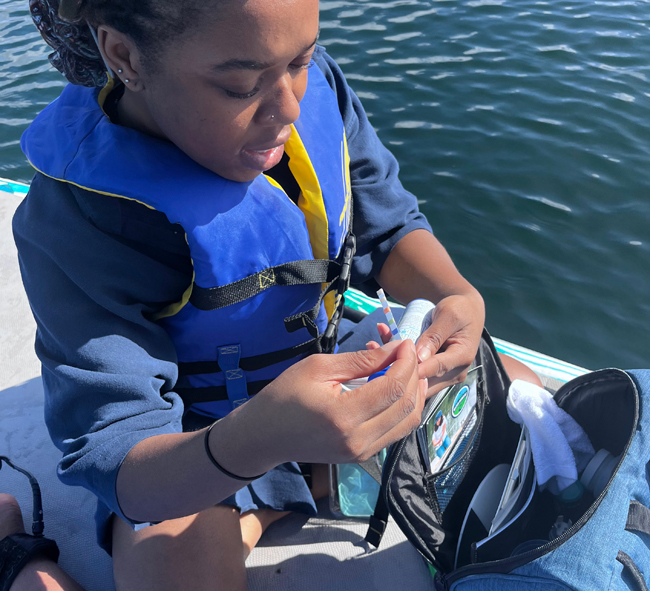
Cornell University researchers working in NY Great Lakes coastal waters will develop eDNA (DNA found in the environment) based tools to simultaneously survey multiple risks in water samples. Here, Water Rangers' Praise Osifo samples the waters of British Columbia. Credit: Nik Maclean
Integrated Biomonitoring of NY Coastal Waters: Aquatic Invasive Species, Fecal Contamination Source Tracking Markers, and Toxic Cyanobacteria (R/XG-35, Dr. Ruth Richardson, and Dr. Jose Andres, Cornell University)
New York’s aquatic environments face a variety of biological threats including Aquatic Invasive Species (AIS), Harmful Algal Blooms (HABs), and waterborne pathogens, among others. These threats have major economic and environmental impacts and require extensive and costly ongoing sentinel biomonitoring efforts.
In a project led by Dr. Ruth Richardson at Cornell University, the research team plans to develop a molecular tool based on environmental DNA (eDNA) to monitor these hazards more efficiently and at a lower cost compared to current standard methods in NY Great Lakes coastal waters . The overall goal is to provide a single, flexible, cost-effective molecular tool for the co-detection of waterborne pathogens, HABs, and AIS. The research will leverage high throughput sequencing methods that only recently have become affordable enough for broad-scale routine implementation and should overcome some of the hurdles faced in other genetic methods. Most current eDNA assays offer the possibility of either single species detection (qPCR) or the characterization of whole communities (metabarcoding). While standard qPCR assays are effective, they become prohibitively expensive when there is a need to detect multiple species. Metabarcoding approaches can detect most of the organisms present in a community, but they require complex bioinformatics analyses.
Building on earlier NYSG-funded eDNA efforts in AIS monitoring in Lake Erie and Lake Ontario, the current approach combines aspects of primer-specific qPCR and metabarcoding and can be tailored to co-detect tens to hundreds of targeted species of interest with high reliability at low cost. This research will enhance management by providing a low-cost rapid tool for early detection of AIS, HABs, etc. in New York coastal waters enabling early, and fast response.
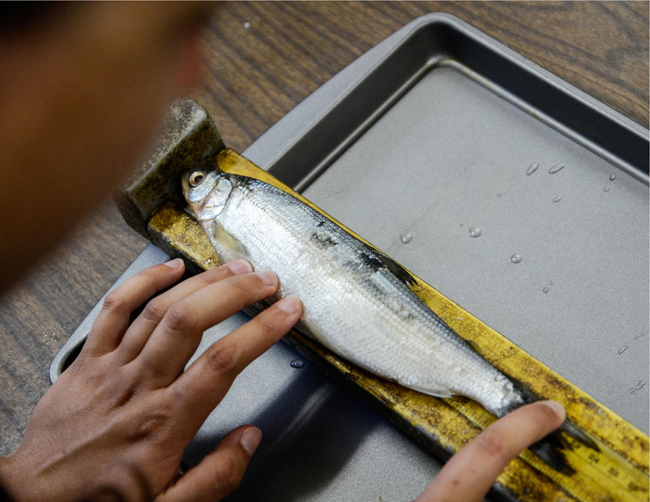
Cisco, the focus of a Cornell University-led project, was once a commercially and ecologically important fish in Lake Ontario. The study described the genetic diversity of cisco populations to inform restoration efforts. Credit: Heather Ainsworth
Navigating Lake Ontario Coregonine Restoration: Analysis of Contemporary and Future Food Web Structures (R/FBF-28, Dr. Lars Rudstam, Dr. James Watkins, Dr. Suresh Sethi, Cornell University)
Restoring native species is believed to improve food web function and mitigate both invasive species disruption and declines in primary production. Coregonine fish (whitefish and ciscoes) restoration has been a management tool used across the Great Lakes basin to stabilize forage fisheries and increase the diversity of the native fish community. Yet, the effectiveness of this practice has not been fully evaluated for Great Lakes ecosystems. Quantifying the potential food web effects at an ecosystem scale should provide fishery managers with information useful to evaluate the potential long-term success of restoration programs and the consequences for population abundances of other prey and predator species.
To do this, a research team at Cornell University led by Dr. Lars Rudstam aims to utilize novel food web modeling tools (Linear Inverse Modeling, LIM) to evaluate the structure and function of Lake Ontario food webs under two scenarios, (a) contemporary food webs (with current coregonine populations), and (b) future food webs with restored coregonine populations (both cisco and deepwater species like bloater). These analyses will provide tools to evaluate the ecosystem-scale outcomes of restoration efforts in the Great Lakes.
Importantly, using LIM food web assessment techniques encompasses key sources of randomness and uncertainty associated with complex food web dynamics that will further assist managers in characterizing the potential variability associated with lake-scale management scenarios.
More Info: New York Sea Grant
New York Sea Grant (NYSG), a cooperative program of Cornell University
and the State University of New York (SUNY), is one of 34 university-based
programs under the National Oceanic and Atmospheric Administration’s
National Sea Grant College Program.
Since 1971, NYSG has represented a statewide network of integrated
research, education and extension services promoting coastal community
economic vitality, environmental sustainability and citizen awareness
and understanding about the State’s marine and Great Lakes resources.
Through NYSG’s efforts, the combined talents of university scientists
and extension specialists help develop and transfer science-based
information to many coastal user groups—businesses and industries,
federal, state and local government decision-makers and agency managers,
educators, the media and the interested public.
The program maintains Great Lakes offices at Cornell University, SUNY
Buffalo, Rochester Institute of Technology, SUNY Oswego, the Wayne County Cooperative Extension office
in Newark, and in Watertown. In the State's marine waters, NYSG has offices at Stony Brook
University and with Cornell Cooperative Extension of Nassau County on Long Island, in Queens, at Brooklyn College, with Cornell Cooperative
Extension in NYC, in Bronx, with Cornell Cooperative Extension of Ulster County in Kingston, and with Cornell Cooperative Extension of Westchester County in Elmsford.
For updates on Sea Grant activities: www.nyseagrant.org has Facebook, Twitter/X, Instagram, and YouTube links. NYSG offers a free e-list sign up via www.nyseagrant.org/nycoastlines for its flagship publication, NY Coastlines/Currents, which is published quarterly.